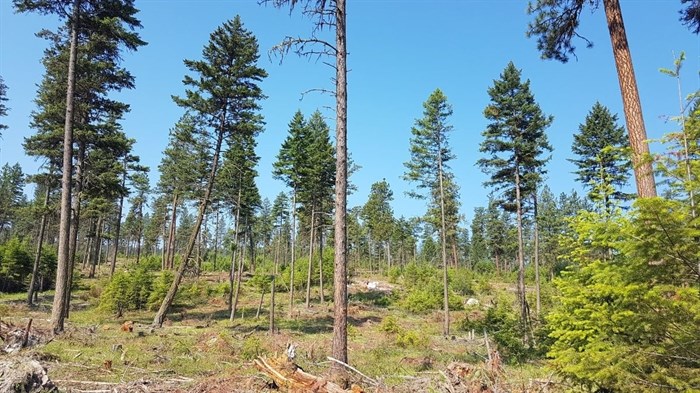
Thinning the forest of trees helps mitigate wildfires.
Image Credit: Forest Enhancement Society of B.C.
September 06, 2021 - 7:00 AM
As a young boy in the 1970s, Mic Werstuik remembers helping his family steward their land by conducting traditional burns for agricultural purposes. Now in his 50s, the West Bank First Nation man is still taking care of the lands, but now he’s doing so as a forester.
Unlike most forestry companies however, the company he works for – Ntityix Resources – looks beyond the value of the lumber.
“We log and we make no bones about that. We log and we feel we do a great job of that,” Werstuik said. “But we do a lot of fuel mitigation work.”
In order to be a steward of the land – somebody truly responsible for managing and protecting it – he said it means striking a healthy balance between the economic, social and spiritual aspects.
Werstuik said that fuel mitigation work conducted by Ntityix Resources helped prevent Mt. Law wildfire near West Kelowna from becoming more severe. That fire is an estimated 976 hectares and still classified as out of control. Last month, B.C. Wildfire Service invited him to take a helicopter tour of the damage. From up in the sky, he could see a definitive line where his team applied their fuel mitigation treatments.
Ntityix Resources uses effective techniques to mitigate fuel in the forest, but none of them include prescribed burnings. Werstuik hopes that will change in the future, but he feels like there’s too much red tape in the way.
It’s hard enough just to burn slash piles, he said. The province only allows that practice to happen during the colder months, and during that period, foresters are often hindered by challenging weather conditions, one set of regulations only allow industrial burnings to only take place when there is sufficient ventilation to disperse smoke, and another set requires burnings to be conducted with minimal risk to air quality.
READ MORE: Prescribed burns aren't just for fire protection, Penticton Indian Band councillor says
Werstuik realizes why the government wants to protect the quality of the air. But he believes the rules may be counter-productive, because when stewards are prevented from burning all their slash piles – which is often then case – the stacks of organic waste get left behind, and if those fuels are used to intensify a wildfire, the overall air quality will become even worse, albeit at a later date.
Back in the late 1970s and 1980s, he would take part in traditional burnings, around 20 acres of his family farm, on an annual basis.
“It kept everything clean, it was basically just a grass fire because we would do them so often,” he said. “We never had any issues with those fires, they never got away on us or anything like that.”
The main purpose for his family was to renew the soil by burning all the dead vegetation above it, which would help the land to grow hay.
“It’s kind of incredible how quickly all of the grasses come back. Within days you see the fresh chutes come back up.”
READ MORE: Fire experts prescribe Indigenous cultural burns to reduce wildfire risk in B.C.
He said that historically, members of the Westbank First Nation knew that fires would increase berry production, which also provided more forage for moose, elk and other ungulates. The cycles would continue as long as the land was burned on a regular basis.
“So every piece of ground in the Central Okanagan would have been burnt every five to 10 years," Werstuik said.
Evidence of those burnings can still be found on the scarred rings of older trees, he said.
As the populations of nearby communities began to grow, Werstuik said the practice of traditional burns started to upset the neighbours.
“It was more or less the urbanization of the Central Okanagan,” he said about the end of traditional burnings on Westbank First Nation lands.
The regional district and local fire departments began to share concerns.
“They felt that it was too risky to keep doing what we were doing. They would come and put out fires out or threaten us with fines if we continued.”
Werstuik believes that forest fires, when set occasionally, are a part of the natural environment, and by suppressing them for so many decades in British Columbia, “catastrophic fires” have become far more common.
But despite the mistakes of the past and the blindspots of the government, Werstuik is optimistic about ongoing dialogues. Especially in 2021, towards the end of another extraordinary fire season, the benefits of traditional Indigenous practices are becoming clearer, he said.
“There are a lot of changes going on right now in regards to reconciliation with First Nations, and First Nations being more involved in the management of natural resources in British Columbia. I think that’s going to result in more traditional practices coming into play.”
To contact a reporter for this story, email Dan Walton or call 250-488-3065 or email the editor. You can also submit photos, videos or news tips to the newsroom and be entered to win a monthly prize draw.
We welcome your comments and opinions on our stories but play nice. We won't censor or delete comments unless they contain off-topic statements or links, unnecessary vulgarity, false facts, spam or obviously fake profiles. If you have any concerns about what you see in comments, email the editor in the link above.
News from © iNFOnews, 2021